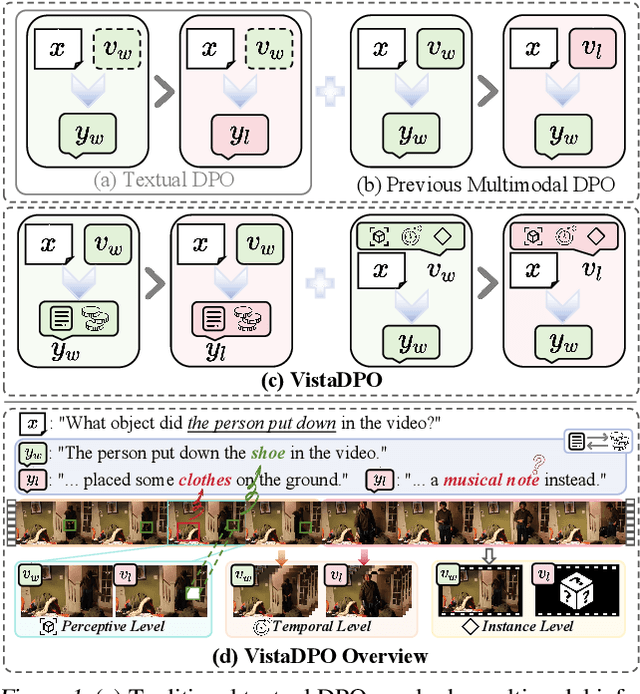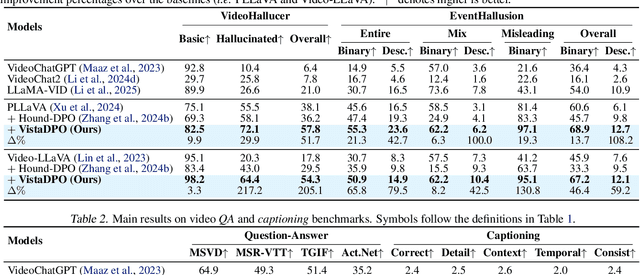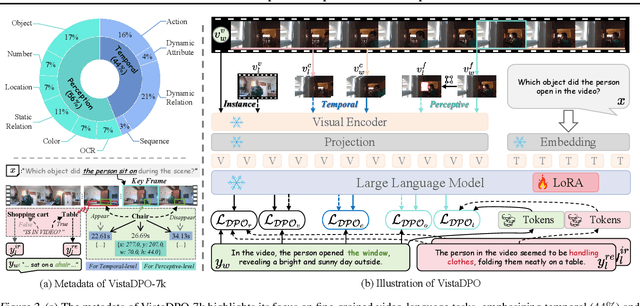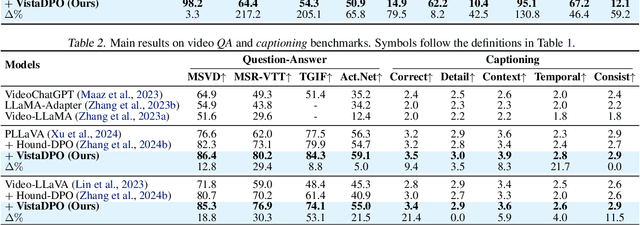Haodong Chen
FinCast: A Foundation Model for Financial Time-Series Forecasting
Aug 27, 2025Abstract:Financial time-series forecasting is critical for maintaining economic stability, guiding informed policymaking, and promoting sustainable investment practices. However, it remains challenging due to various underlying pattern shifts. These shifts arise primarily from three sources: temporal non-stationarity (distribution changes over time), multi-domain diversity (distinct patterns across financial domains such as stocks, commodities, and futures), and varying temporal resolutions (patterns differing across per-second, hourly, daily, or weekly indicators). While recent deep learning methods attempt to address these complexities, they frequently suffer from overfitting and typically require extensive domain-specific fine-tuning. To overcome these limitations, we introduce FinCast, the first foundation model specifically designed for financial time-series forecasting, trained on large-scale financial datasets. Remarkably, FinCast exhibits robust zero-shot performance, effectively capturing diverse patterns without domain-specific fine-tuning. Comprehensive empirical and qualitative evaluations demonstrate that FinCast surpasses existing state-of-the-art methods, highlighting its strong generalization capabilities.
MultiMedEdit: A Scenario-Aware Benchmark for Evaluating Knowledge Editing in Medical VQA
Aug 09, 2025Abstract:Knowledge editing (KE) provides a scalable approach for updating factual knowledge in large language models without full retraining. While previous studies have demonstrated effectiveness in general domains and medical QA tasks, little attention has been paid to KE in multimodal medical scenarios. Unlike text-only settings, medical KE demands integrating updated knowledge with visual reasoning to support safe and interpretable clinical decisions. To address this gap, we propose MultiMedEdit, the first benchmark tailored to evaluating KE in clinical multimodal tasks. Our framework spans both understanding and reasoning task types, defines a three-dimensional metric suite (reliability, generality, and locality), and supports cross-paradigm comparisons across general and domain-specific models. We conduct extensive experiments under single-editing and lifelong-editing settings. Results suggest that current methods struggle with generalization and long-tail reasoning, particularly in complex clinical workflows. We further present an efficiency analysis (e.g., edit latency, memory footprint), revealing practical trade-offs in real-world deployment across KE paradigms. Overall, MultiMedEdit not only reveals the limitations of current approaches but also provides a solid foundation for developing clinically robust knowledge editing techniques in the future.
MGDFIS: Multi-scale Global-detail Feature Integration Strategy for Small Object Detection
Jun 15, 2025Abstract:Small object detection in UAV imagery is crucial for applications such as search-and-rescue, traffic monitoring, and environmental surveillance, but it is hampered by tiny object size, low signal-to-noise ratios, and limited feature extraction. Existing multi-scale fusion methods help, but add computational burden and blur fine details, making small object detection in cluttered scenes difficult. To overcome these challenges, we propose the Multi-scale Global-detail Feature Integration Strategy (MGDFIS), a unified fusion framework that tightly couples global context with local detail to boost detection performance while maintaining efficiency. MGDFIS comprises three synergistic modules: the FusionLock-TSS Attention Module, which marries token-statistics self-attention with DynamicTanh normalization to highlight spectral and spatial cues at minimal cost; the Global-detail Integration Module, which fuses multi-scale context via directional convolution and parallel attention while preserving subtle shape and texture variations; and the Dynamic Pixel Attention Module, which generates pixel-wise weighting maps to rebalance uneven foreground and background distributions and sharpen responses to true object regions. Extensive experiments on the VisDrone benchmark demonstrate that MGDFIS consistently outperforms state-of-the-art methods across diverse backbone architectures and detection frameworks, achieving superior precision and recall with low inference time. By striking an optimal balance between accuracy and resource usage, MGDFIS provides a practical solution for small-object detection on resource-constrained UAV platforms.
Learning Fine-Grained Geometry for Sparse-View Splatting via Cascade Depth Loss
May 28, 2025Abstract:Novel view synthesis is a fundamental task in 3D computer vision that aims to reconstruct realistic images from a set of posed input views. However, reconstruction quality degrades significantly under sparse-view conditions due to limited geometric cues. Existing methods, such as Neural Radiance Fields (NeRF) and the more recent 3D Gaussian Splatting (3DGS), often suffer from blurred details and structural artifacts when trained with insufficient views. Recent works have identified the quality of rendered depth as a key factor in mitigating these artifacts, as it directly affects geometric accuracy and view consistency. In this paper, we address these challenges by introducing Hierarchical Depth-Guided Splatting (HDGS), a depth supervision framework that progressively refines geometry from coarse to fine levels. Central to HDGS is a novel Cascade Pearson Correlation Loss (CPCL), which aligns rendered and estimated monocular depths across multiple spatial scales. By enforcing multi-scale depth consistency, our method substantially improves structural fidelity in sparse-view scenarios. Extensive experiments on the LLFF and DTU benchmarks demonstrate that HDGS achieves state-of-the-art performance under sparse-view settings while maintaining efficient and high-quality rendering
A Survey of LLM $\times$ DATA
May 24, 2025Abstract:The integration of large language model (LLM) and data management (DATA) is rapidly redefining both domains. In this survey, we comprehensively review the bidirectional relationships. On the one hand, DATA4LLM, spanning large-scale data processing, storage, and serving, feeds LLMs with high quality, diversity, and timeliness of data required for stages like pre-training, post-training, retrieval-augmented generation, and agentic workflows: (i) Data processing for LLMs includes scalable acquisition, deduplication, filtering, selection, domain mixing, and synthetic augmentation; (ii) Data Storage for LLMs focuses on efficient data and model formats, distributed and heterogeneous storage hierarchies, KV-cache management, and fault-tolerant checkpointing; (iii) Data serving for LLMs tackles challenges in RAG (e.g., knowledge post-processing), LLM inference (e.g., prompt compression, data provenance), and training strategies (e.g., data packing and shuffling). On the other hand, in LLM4DATA, LLMs are emerging as general-purpose engines for data management. We review recent advances in (i) data manipulation, including automatic data cleaning, integration, discovery; (ii) data analysis, covering reasoning over structured, semi-structured, and unstructured data, and (iii) system optimization (e.g., configuration tuning, query rewriting, anomaly diagnosis), powered by LLM techniques like retrieval-augmented prompting, task-specialized fine-tuning, and multi-agent collaboration.
FinePhys: Fine-grained Human Action Generation by Explicitly Incorporating Physical Laws for Effective Skeletal Guidance
May 19, 2025Abstract:Despite significant advances in video generation, synthesizing physically plausible human actions remains a persistent challenge, particularly in modeling fine-grained semantics and complex temporal dynamics. For instance, generating gymnastics routines such as "switch leap with 0.5 turn" poses substantial difficulties for current methods, often yielding unsatisfactory results. To bridge this gap, we propose FinePhys, a Fine-grained human action generation framework that incorporates Physics to obtain effective skeletal guidance. Specifically, FinePhys first estimates 2D poses in an online manner and then performs 2D-to-3D dimension lifting via in-context learning. To mitigate the instability and limited interpretability of purely data-driven 3D poses, we further introduce a physics-based motion re-estimation module governed by Euler-Lagrange equations, calculating joint accelerations via bidirectional temporal updating. The physically predicted 3D poses are then fused with data-driven ones, offering multi-scale 2D heatmap guidance for the diffusion process. Evaluated on three fine-grained action subsets from FineGym (FX-JUMP, FX-TURN, and FX-SALTO), FinePhys significantly outperforms competitive baselines. Comprehensive qualitative results further demonstrate FinePhys's ability to generate more natural and plausible fine-grained human actions.
A Survey of 3D Reconstruction with Event Cameras: From Event-based Geometry to Neural 3D Rendering
May 13, 2025Abstract:Event cameras have emerged as promising sensors for 3D reconstruction due to their ability to capture per-pixel brightness changes asynchronously. Unlike conventional frame-based cameras, they produce sparse and temporally rich data streams, which enable more accurate 3D reconstruction and open up the possibility of performing reconstruction in extreme environments such as high-speed motion, low light, or high dynamic range scenes. In this survey, we provide the first comprehensive review focused exclusively on 3D reconstruction using event cameras. The survey categorises existing works into three major types based on input modality - stereo, monocular, and multimodal systems, and further classifies them by reconstruction approach, including geometry-based, deep learning-based, and recent neural rendering techniques such as Neural Radiance Fields and 3D Gaussian Splatting. Methods with a similar research focus were organised chronologically into the most subdivided groups. We also summarise public datasets relevant to event-based 3D reconstruction. Finally, we highlight current research limitations in data availability, evaluation, representation, and dynamic scene handling, and outline promising future research directions. This survey aims to serve as a comprehensive reference and a roadmap for future developments in event-driven 3D reconstruction.
VistaDPO: Video Hierarchical Spatial-Temporal Direct Preference Optimization for Large Video Models
Apr 17, 2025



Abstract:Large Video Models (LVMs) built upon Large Language Models (LLMs) have shown promise in video understanding but often suffer from misalignment with human intuition and video hallucination issues. To address these challenges, we introduce VistaDPO, a novel framework for Video Hierarchical Spatial-Temporal Direct Preference Optimization. VistaDPO enhances text-video preference alignment across three hierarchical levels: i) Instance Level, aligning overall video content with responses; ii) Temporal Level, aligning video temporal semantics with event descriptions; and iii) Perceptive Level, aligning spatial objects with language tokens. Given the lack of datasets for fine-grained video-language preference alignment, we construct VistaDPO-7k, a dataset of 7.2K QA pairs annotated with chosen and rejected responses, along with spatial-temporal grounding information such as timestamps, keyframes, and bounding boxes. Extensive experiments on benchmarks such as Video Hallucination, Video QA, and Captioning performance tasks demonstrate that VistaDPO significantly improves the performance of existing LVMs, effectively mitigating video-language misalignment and hallucination. The code and data are available at https://github.com/HaroldChen19/VistaDPO.
A Survey on Event-driven 3D Reconstruction: Development under Different Categories
Mar 26, 2025



Abstract:Event cameras have gained increasing attention for 3D reconstruction due to their high temporal resolution, low latency, and high dynamic range. They capture per-pixel brightness changes asynchronously, allowing accurate reconstruction under fast motion and challenging lighting conditions. In this survey, we provide a comprehensive review of event-driven 3D reconstruction methods, including stereo, monocular, and multimodal systems. We further categorize recent developments based on geometric, learning-based, and hybrid approaches. Emerging trends, such as neural radiance fields and 3D Gaussian splatting with event data, are also covered. The related works are structured chronologically to illustrate the innovations and progression within the field. To support future research, we also highlight key research gaps and future research directions in dataset, experiment, evaluation, event representation, etc.
SeFAR: Semi-supervised Fine-grained Action Recognition with Temporal Perturbation and Learning Stabilization
Jan 02, 2025



Abstract:Human action understanding is crucial for the advancement of multimodal systems. While recent developments, driven by powerful large language models (LLMs), aim to be general enough to cover a wide range of categories, they often overlook the need for more specific capabilities. In this work, we address the more challenging task of Fine-grained Action Recognition (FAR), which focuses on detailed semantic labels within shorter temporal duration (e.g., "salto backward tucked with 1 turn"). Given the high costs of annotating fine-grained labels and the substantial data needed for fine-tuning LLMs, we propose to adopt semi-supervised learning (SSL). Our framework, SeFAR, incorporates several innovative designs to tackle these challenges. Specifically, to capture sufficient visual details, we construct Dual-level temporal elements as more effective representations, based on which we design a new strong augmentation strategy for the Teacher-Student learning paradigm through involving moderate temporal perturbation. Furthermore, to handle the high uncertainty within the teacher model's predictions for FAR, we propose the Adaptive Regulation to stabilize the learning process. Experiments show that SeFAR achieves state-of-the-art performance on two FAR datasets, FineGym and FineDiving, across various data scopes. It also outperforms other semi-supervised methods on two classical coarse-grained datasets, UCF101 and HMDB51. Further analysis and ablation studies validate the effectiveness of our designs. Additionally, we show that the features extracted by our SeFAR could largely promote the ability of multimodal foundation models to understand fine-grained and domain-specific semantics.
 Add to Chrome
Add to Chrome Add to Firefox
Add to Firefox Add to Edge
Add to Edge